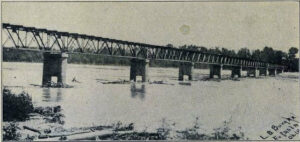The Jefferson Highway Bridge in Eufaula, Oklahoma
by:
Glenn Smith

The biggest problem confronting the development of the route in Oklahoma clearly was getting motorists across the Canadian River near Eufaula in McIntosh County. This river had a long history of being difficult to cross, having yielded several fatalities of persons attempting to do so. A very sandy riverbed and constantly changing water depth created quicksand at many places. At that time, the only way to cross the river was by ferry, but the combination of shifting sand and constant changes in the depth of the river made the ferry unreliable and completely inadequate for securing steady movement of traffic. All “good roads” advocates, and especially the Jefferson Highway Association, knew this problem had to be resolved, and soon it was evident that only a substantial bridge built across the Canadian River would ensure that the Jefferson Highway continued to be routed through McIntosh and Pittsburg Counties, or even through that section of Oklahoma generally.
As it happened, the annual meeting of the Jefferson Highway Association was held in Muskogee, Oklahoma, in November 1916, and at that meeting the JHA directors also happened to elect David N. Fink, the well-known banker from Muskogee, to serve as President of the JHA for the upcoming year. Fink began his term with an all-out effort to get the bridge built over the Canadian River.
The great length of the bridge and the large number of piers that would be needed meant that this would be, for that time, a very expensive project. Posing an even greater obstacle to fast action, however, was the constant bickering between residents of Eufaula and McAlester, located on opposite sides of the river, over the location of the bridge. Determined to force a decision on the question and to get the bridge project underway, early in 1917 JHA general manager J.D. Clarkson summoned representatives from the two cities to a meeting at which JHA president Fink very forcefully presided. No one there could have mistaken the purpose or importance of the meeting, the stark reality of which was recorded succinctly in the McAlester newspaper, The News-Capital: “It is time to act now, or lose the Jefferson Highway, according to an ultimatum given Tuesday afternoon by officials of the Jefferson Highway Association.” The ultimatum marvelously helped to concentrate the minds of those present, and within a little less than three hours, all the questions of bridge location and project finance had at last been settled.
What the parties agreed to do was to build a toll bridge at an estimated cost of $150,000. Eufaula was to select the location of the bridge and for that privilege would pledge $60,000 of the cost. In return for accepting that decision, McAlester was obligated to take only $15,000 in stock in the new bridge company. The remaining $75,000 was to be raised by the sale of bonds.
The full funding needed to begin construction was not in hand until late August 1917, after which the new Jefferson Highway Bridge Company faced further construction delays caused by the shortages of labor and steel during World War I. The company that was contracted to build the bridge also found that they needed to dig fifty feet down before reaching rock sufficient for setting the piers, yielding more delay (as well as a claimed loss by the company of $60,000 on the project). In July 1919, the unfinished bridge was christened by the wife of the Louisiana governor on a JHA sociability run from New Orleans to Winnipeg. Not until April 21, 1920, however, was the bridge completed—an immense structure of twelve steel spans set in concrete piers, paved in asphalt macadam, having a length (including approaches) of 3,142 feet, and built 40 feet above the low water mark. Securing this last feature had added to the project’s cost, which reached a final total of close to a quarter of a million dollars.
The bridge was operated as a toll bridge until the Oklahoma Highway Department bought it in 1928 and made it a free bridge. In the 1950s, that department built a new road and bridge for U.S. 69, the Jefferson’s eventual successor in Oklahoma, on the west side of Eufaula, bypassing the town. The old bridge was then put to use in carrying traffic on State Highway 9. At the same time, however, the state had begun to build the Eufaula Dam, a project completed in 1964, and also built a new two-lane bridge for Highway 9. The old bridge was taken out for salvage just before Eufaula Lake, the largest man-made lake in the United States, filled with water. Although it was once touted as the largest, longest, and most expensive bridge in Oklahoma, and certainly was one of the major accomplishments of the Jefferson Highway Association, sadly no evidences of this great bridge remain today.



